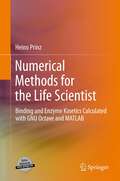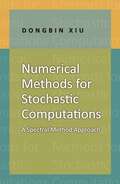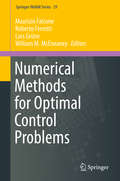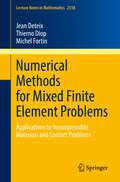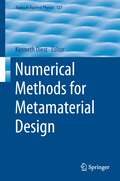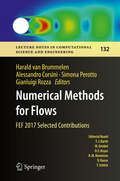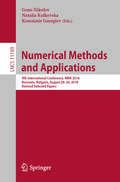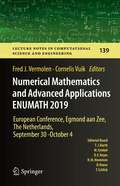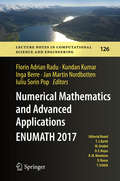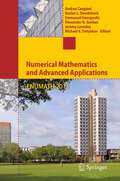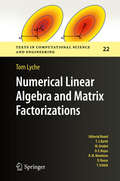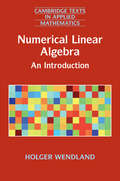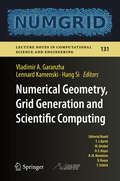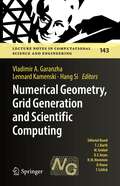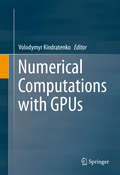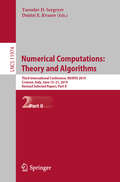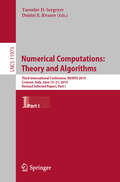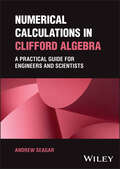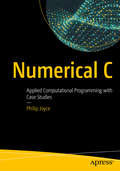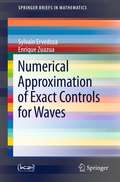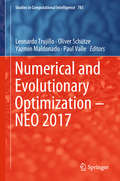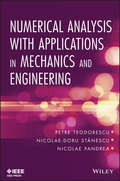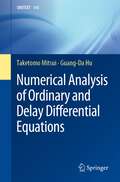- Table View
- List View
Numerical Methods for the Life Scientist
by Heino PrinzEnzyme kinetics, binding kinetics and pharmacological dose-response curves are currently analyzed by a few standard methods. Some of these, like Michaelis-Menten enzyme kinetics, use plausible approximations, others, like Hill equations for dose-response curves, are outdated. Calculating realistic reaction schemes requires numerical mathematical routines which usually are not covered in the curricula of life science. This textbook will give a step-by-step introduction to numerical solutions of non-linear and differential equations. It will be accompanied with a set of programs to calculate any reaction scheme on any personal computer. Typical examples from analytical biochemistry and pharmacology can be used as versatile templates. When a reaction scheme is applied for data fitting, the resulting parameters may not be unique. Correlation of parameters will be discussed and simplification strategies will be offered.
Numerical Methods for Stochastic Computations: A Spectral Method Approach
by Dongbin XiuThe@ first graduate-level textbook to focus on fundamental aspects of numerical methods for stochastic computations, this book describes the class of numerical methods based on generalized polynomial chaos (gPC). These fast, efficient, and accurate methods are an extension of the classical spectral methods of high-dimensional random spaces. Designed to simulate complex systems subject to random inputs, these methods are widely used in many areas of computer science and engineering. The book introduces polynomial approximation theory and probability theory; describes the basic theory of gPC methods through numerical examples and rigorous development; details the procedure for converting stochastic equations into deterministic ones; using both the Galerkin and collocation approaches; and discusses the distinct differences and challenges arising from high-dimensional problems. The last section is devoted to the application of gPC methods to critical areas such as inverse problems and data assimilation. Ideal for use by graduate students and researchers both in the classroom and for self-study, Numerical Methods for Stochastic Computations provides the required tools for in-depth research related to stochastic computations. The first graduate-level textbook to focus on the fundamentals of numerical methods for stochastic computations Ideal introduction for graduate courses or self-study Fast, efficient, and accurate numerical methods Polynomial approximation theory and probability theory included Basic gPC methods illustrated through examples
Numerical Methods for Optimal Control Problems (Springer INdAM Series #29)
by Maurizio Falcone Roberto Ferretti Lars Grüne William M. McEneaneyThis work presents recent mathematical methods in the area of optimal control with a particular emphasis on the computational aspects and applications. Optimal control theory concerns the determination of control strategies for complex dynamical systems, in order to optimize some measure of their performance. Started in the 60's under the pressure of the "space race" between the US and the former USSR, the field now has a far wider scope, and embraces a variety of areas ranging from process control to traffic flow optimization, renewable resources exploitation and management of financial markets. These emerging applications require more and more efficient numerical methods for their solution, a very difficult task due the huge number of variables. The chapters of this volume give an up-to-date presentation of several recent methods in this area including fast dynamic programming algorithms, model predictive control and max-plus techniques. This book is addressed to researchers, graduate students and applied scientists working in the area of control problems, differential games and their applications.
Numerical Methods for Mixed Finite Element Problems: Applications to Incompressible Materials and Contact Problems (Lecture Notes in Mathematics #2318)
by Jean Deteix Thierno Diop Michel FortinThis book focuses on iterative solvers and preconditioners for mixed finite element methods. It provides an overview of some of the state-of-the-art solvers for discrete systems with constraints such as those which arise from mixed formulations.Starting by recalling the basic theory of mixed finite element methods, the book goes on to discuss the augmented Lagrangian method and gives a summary of the standard iterative methods, describing their usage for mixed methods. Here, preconditioners are built from an approximate factorisation of the mixed system.A first set of applications is considered for incompressible elasticity problems and flow problems, including non-linear models.An account of the mixed formulation for Dirichlet’s boundary conditions is then given before turning to contact problems, where contact between incompressible bodies leads to problems with two constraints.This book is aimed at graduate students and researchers in the field of numerical methods and scientific computing.
Numerical Methods for Metamaterial Design
by Kenneth DiestThis book describes a relatively new approach for the design of electromagnetic metamaterials. Numerical optimization routines are combined with electromagnetic simulations to tailor the broadband optical properties of a metamaterial to have predetermined responses at predetermined wavelengths. After a review of both the major efforts within the field of metamaterials and the field of mathematical optimization, chapters covering both gradient-based and derivative-free design methods are considered. Selected topics including surrogate-base optimization, adaptive mesh search, and genetic algorithms are shown to be effective, gradient-free optimization strategies. Additionally, new techniques for representing dielectric distributions in two dimensions, including level sets, are demonstrated as effective methods for gradient-based optimization. Each chapter begins with a rigorous review of the optimization strategy used, and is followed by numerous examples that combine the strategy with either electromagnetic simulations or analytical solutions of the scattering problem. Throughout the text, we address the strengths and limitations of each method, as well as which numerical methods are best suited for different types of metamaterial designs. This book is intended to provide a detailed enough treatment of the mathematical methods used, along with sufficient examples and additional references, that senior level undergraduates or graduate students who are new to the fields of plasmonics, metamaterials, or optimization methods; have an understanding of which approaches are best-suited for their work and how to implement the methods themselves.
Numerical Methods for Flows: FEF 2017 Selected Contributions (Lecture Notes in Computational Science and Engineering #132)
by Gianluigi Rozza Simona Perotto Harald Van Brummelen Alessandro CorsiniThis book includes selected contributions on applied mathematics, numerical analysis, numerical simulation and scientific computing related to fluid mechanics problems, presented at the FEF-“Finite Element for Flows” conference, held in Rome in spring 2017. Written by leading international experts and covering state-of-the-art topics in numerical simulation for flows, it provides fascinating insights into and perspectives on current and future methodological and numerical developments in computational science. As such, the book is a valuable resource for researchers, as well as Masters and Ph.D students.
Numerical Methods and Applications: 9th International Conference, NMA 2018, Borovets, Bulgaria, August 20-24, 2018, Revised Selected Papers (Lecture Notes in Computer Science #11189)
by Geno Nikolov Natalia Kolkovska Krassimir GeorgievThis book constitutes the thoroughly refereed post-conference proceedings of the 9th International Conference on Numerical Methods and Applications, NMA 2018, held in Borovets, Bulgaria, in August 2018. The 56 revised regular papers presented were carefully reviewed and selected from 61 submissions for inclusion in this book. The papers are organized in the following topical sections: numerical search and optimization; problem-driven numerical method: motivation and application, numerical methods for fractional diffusion problems; orthogonal polynomials and numerical quadratures; and Monte Carlo and Quasi-Monte Carlo methods.
Numerical Mathematics and Advanced Applications ENUMATH 2019: European Conference, Egmond aan Zee, The Netherlands, September 30 - October 4 (Lecture Notes in Computational Science and Engineering #139)
by Fred J. Vermolen Cornelis VuikThis book gathers outstanding papers presented at the European Conference on Numerical Mathematics and Advanced Applications (ENUMATH 2019). The conference was organized by Delft University of Technology and was held in Egmond aan Zee, the Netherlands, from September 30 to October 4, 2019. Leading experts in the field presented the latest results and ideas regarding the design, implementation and analysis of numerical algorithms, as well as their applications to relevant societal problems.ENUMATH is a series of conferences held every two years to provide a forum for discussing basic aspects and new trends in numerical mathematics and scientific and industrial applications, all examined at the highest level of international expertise. The first ENUMATH was held in Paris in 1995, with successive installments at various sites across Europe, including Heidelberg (1997), Jyvaskyla (1999), lschia Porto (2001), Prague (2003), Santiago de Compostela (2005), Graz (2007), Uppsala (2009), Leicester (2011), Lausanne (2013), Ankara (2015) and Bergen (2017).
Numerical Mathematics and Advanced Applications ENUMATH 2017 (Lecture Notes in Computational Science and Engineering #126)
by Florin Adrian Radu Kundan Kumar Inga Berre Jan Martin Nordbotten Iuliu Sorin PopThis book collects many of the presented papers, as plenary presentations, mini-symposia invited presentations, or contributed talks, from the European Conference on Numerical Mathematics and Advanced Applications (ENUMATH) 2017. The conference was organized by the University of Bergen, Norway from September 25 to 29, 2017. Leading experts in the field presented the latest results and ideas in the designing, implementation, and analysis of numerical algorithms as well as their applications to relevant, societal problems.ENUMATH is a series of conferences held every two years to provide a forum for discussing basic aspects and new trends in numerical mathematics and scientific and industrial applications. These discussions are upheld at the highest level of international expertise. The first ENUMATH conference was held in Paris in 1995 with successive conferences being held at various locations across Europe, including Heidelberg (1997), Jyvaskyla (1999), lschia Porto (2001), Prague (2003), Santiago de Compostela (2005), Graz (2007), Uppsala (2009), Leicester (2011), Lausanne (2013), and Ankara (2015).
Numerical Mathematics and Advanced Applications 2011
by Alexander N. Gorban Andrea Cangiani Emmanuil Georgoulis Jeremy Levesley Michael V. Tretyakov Ruslan L DavidchackThe European Conferences on Numerical Mathematics and Advanced Applications (ENUMATH) are a series of conferences held every two years to provide a forum for discussion of new trends in numerical mathematics and challenging scientific and industrial applications at the highest level of international expertise. ENUMATH 2011 was hosted by the University of Leicester (UK) from the 5th to 9th September 2011. This proceedings volume contains more than 90 papers by speakers of the conference and gives an overview of recent developments in scientific computing, numerical analysis, and practical use of modern numerical techniques and algorithms in various applications. New results on finite element methods, multiscale methods, numerical linear algebra, and finite difference schemes are presented. A range of applications include computational problems from fluid dynamics, materials, image processing, and molecular dynamics.
Numerical Linear Algebra and Matrix Factorizations (Texts in Computational Science and Engineering #22)
by Tom LycheAfter reading this book, students should be able to analyze computational problems in linear algebra such as linear systems, least squares- and eigenvalue problems, and to develop their own algorithms for solving them. Since these problems can be large and difficult to handle, much can be gained by understanding and taking advantage of special structures. This in turn requires a good grasp of basic numerical linear algebra and matrix factorizations. Factoring a matrix into a product of simpler matrices is a crucial tool in numerical linear algebra, because it allows us to tackle complex problems by solving a sequence of easier ones. The main characteristics of this book are as follows: It is self-contained, only assuming that readers have completed first-year calculus and an introductory course on linear algebra, and that they have some experience with solving mathematical problems on a computer. The book provides detailed proofs of virtually all results. Further, its respective parts can be used independently, making it suitable for self-study. The book consists of 15 chapters, divided into five thematically oriented parts. The chapters are designed for a one-week-per-chapter, one-semester course. To facilitate self-study, an introductory chapter includes a brief review of linear algebra.
Numerical Linear Algebra: An Introduction (Cambridge Texts in Applied Mathematics #56)
by Holger WendlandThis self-contained introduction to numerical linear algebra provides a comprehensive, yet concise, overview of the subject. It includes standard material such as direct methods for solving linear systems and least-squares problems, error, stability and conditioning, basic iterative methods and the calculation of eigenvalues. Later chapters cover more advanced material, such as Krylov subspace methods, multigrid methods, domain decomposition methods, multipole expansions, hierarchical matrices and compressed sensing. The book provides rigorous mathematical proofs throughout, and gives algorithms in general-purpose language-independent form. Requiring only a solid knowledge in linear algebra and basic analysis, this book will be useful for applied mathematicians, engineers, computer scientists, and all those interested in efficiently solving linear problems.
Numerical Geometry, Grid Generation and Scientific Computing: Proceedings of the 9th International Conference, NUMGRID 2018 / Voronoi 150, Celebrating the 150th Anniversary of G.F. Voronoi, Moscow, Russia, December 2018 (Lecture Notes in Computational Science and Engineering #131)
by Vladimir A. Garanzha Lennard Kamenski Hang SiThe focus of these conference proceedings is on research, development, and applications in the fields of numerical geometry, scientific computing and numerical simulation, particularly in mesh generation and related problems. In addition, this year’s special focus is on Voronoi diagrams and their applications, celebrating the 150th birthday of G.F. Voronoi. In terms of content, the book strikes a balance between engineering algorithms and mathematical foundations. It presents an overview of recent advances in numerical geometry, grid generation and adaptation in terms of mathematical foundations, algorithm and software development and applications. The specific topics covered include: quasi-conformal and quasi-isometric mappings, hyperelastic deformations, multidimensional generalisations of the equidistribution principle, discrete differential geometry, spatial and metric encodings, Voronoi-Delaunay theory for tilings and partitions, duality in mathematical programming and numerical geometry, mesh-based optimisation and optimal control methods. Further aspects examined include iterative solvers for variational problems and algorithm and software development. The applications of the methods discussed are multidisciplinary and include problems from mathematics, physics, biology, chemistry, material science, and engineering.
Numerical Geometry, Grid Generation and Scientific Computing: Proceedings of the 10th International Conference, NUMGRID 2020 / Delaunay 130, Celebrating the 130th Anniversary of Boris Delaunay, Moscow, Russia, November 2020 (Lecture Notes in Computational Science and Engineering #143)
by Vladimir A. Garanzha Lennard Kamenski Hang SiThe focus of these conference proceedings is on research, development, and applications in the fields of numerical geometry, scientific computing and numerical simulation, particularly in mesh generation and related problems. In addition, this year’s special focus is on Delaunay triangulations and their applications, celebrating the 130th birthday of Boris Delaunay. In terms of content, the book strikes a balance between engineering algorithms and mathematical foundations. It presents an overview of recent advances in numerical geometry, grid generation and adaptation in terms of mathematical foundations, algorithm and software development and applications. The specific topics covered include: quasi-conformal and quasi-isometric mappings, hyperelastic deformations, multidimensional generalisations of the equidistribution principle, discrete differential geometry, spatial and metric encodings, Voronoi-Delaunay theory for tilings and partitions, duality in mathematical programming and numerical geometry, mesh-based optimisation and optimal control methods. Further aspects examined include iterative solvers for variational problems and algorithm and software development. The applications of the methods discussed are multidisciplinary and include problems from mathematics, physics, biology, chemistry, material science, and engineering.
Numerical Computations with GPUs
by Volodymyr KindratenkoThis book brings together research on numerical methods adapted for Graphics Processing Units (GPUs). It explains recent efforts to adapt classic numerical methods, including solution of linear equations and FFT, for massively parallel GPU architectures. This volume consolidates recent research and adaptations, covering widely used methods that are at the core of many scientific and engineering computations. Each chapter is written by authors working on a specific group of methods; these leading experts provide mathematical background, parallel algorithms and implementation details leading to reusable, adaptable and scalable code fragments. This book also serves as a GPU implementation manual for many numerical algorithms, sharing tips on GPUs that can increase application efficiency. The valuable insights into parallelization strategies for GPUs are supplemented by ready-to-use code fragments. Numerical Computations with GPUs targets professionals and researchers working in high performance computing and GPU programming. Advanced-level students focused on computer science and mathematics will also find this book useful as secondary text book or reference.
Numerical Computations: Third International Conference, NUMTA 2019, Crotone, Italy, June 15–21, 2019, Revised Selected Papers, Part II (Lecture Notes in Computer Science #11974)
by Yaroslav D. Sergeyev Dmitri E. KvasovThe two-volume set LNCS 11973 and 11974 constitute revised selected papers from the Third International Conference on Numerical Computations: Theory and Algorithms, NUMTA 2019, held in Crotone, Italy, in June 2019. This volume, LNCS 11974, consists of 19 full and 32 short papers chosen among regular papers presented at the the Conference including also the paper of the winner (Lorenzo Fiaschi, Pisa, Italy) of The Springer Young Researcher Prize for the best NUMTA 2019 presentation made by a young scientist. The papers in part II explore the advanced research developments in such interconnected fields as local and global optimization, machine learning, approximation, and differential equations. A special focus is given to advanced ideas related to methods and applications using emerging computational paradigms.
Numerical Computations: Third International Conference, NUMTA 2019, Crotone, Italy, June 15–21, 2019, Revised Selected Papers, Part I (Lecture Notes in Computer Science #11973)
by Yaroslav D. Sergeyev Dmitri E. KvasovThe two-volume set LNCS 11973 and 11974 constitute revised selected papers from the Third International Conference on Numerical Computations: Theory and Algorithms, NUMTA 2019, held in Crotone, Italy, in June 2019. This volume, LNCS 11973, consists of 34 full and 18 short papers chosen among papers presented at special streams and sessions of the Conference. The papers in part I were organized following the topics of these special sessions: approximation: methods, algorithms, and applications; computational methods for data analysis; first order methods in optimization: theory and applications; high performance computing in modelling and simulation; numbers, algorithms, and applications; optimization and management of water supply.
Numerical Calculations in Clifford Algebra: A Practical Guide for Engineers and Scientists
by Andrew SeagarNUMERICAL CALCULATIONS IN CLIFFORD ALGEBRA An intuitive combination of the theory of Clifford algebra with numerous worked and computed examples and calculations Numerical Calculations in Clifford Algebra: A Practical Guide for Engineers and Scientists is an accessible and practical introduction to Clifford algebra, with comprehensive coverage of the theory and calculations. The book offers many worked and computed examples at a variety of levels of complexity and over a range of different applications making extensive use of diagrams to maintain clarity. The author introduces and documents the Clifford Numerical Suite, developed to overcome the limitations of existing computational packages and to enable the rapid creation and deployment of sophisticated and efficient code. Applications of the suite include Fourier transforms for arrays of any types of Clifford numbers and the solution of linear systems in which the coefficients are Clifford numbers of particular types, including scalars, bicomplex numbers, quaternions, Pauli matrices, and extended electromagnetic fields. Readers will find: A thorough introduction to Clifford algebra, with a combination of theory and practical implementation in a range of engineering problems Comprehensive explorations of a variety of worked and computed examples at various levels of complexity Practical discussions of the conceptual and computational tools for solving common engineering problems Detailed documentation on the deployment and application of the Clifford Numerical Suite Perfect for engineers, researchers, and academics with an interest in Clifford algebra, Numerical Calculations in Clifford Algebra: A Practical Guide for Engineers and Scientists will particularly benefit professionals in the areas of antenna design, digital image processing, theoretical physics, and geometry.
Numerical C: Applied Computational Programming with Case Studies
by Philip JoyceLearn applied numerical computing using the C programming language, starting with a quick primer on the C programming language and its SDK. This book then dives into progressively more complex applied math formula for computational methods using C with examples throughout and a larger, more complete application towards the end. Numerical C starts with the quadratic formula for finding solutions to algebraic equations that model things such as price vs. demand or rise vs. run or slip and more. Later in the book, you'll work on the augmented matrix method for simultaneous equations. You’ll also cover Monte Carlo method model objects that could arise naturally as part of the modeling of a real-life system, such as a complex road network, the transport of neutrons, or the evolution of the stock market. Furthermore, the Monte Carlo method of integration examines the area under a curve including rendering or ray tracing and the shading in a region. Furthermore, you'll work with the product moment correlation coefficient: correlation is a technique for investigating the relationship between two quantitative, continuous variables, for example, age and blood pressure. By the end of the book, you'll have a feeling for what computer software could do to help you in your work and apply some of the methods learned directly to your work. What You Will LearnGain software and C programming basicsWrite software to solve applied, computational mathematics problems Create programs to solve equations and calculus problems Use the trapezium method, Monte Carlo method, line of best fit, product moment correlation coefficient, Simpson’s rule, and matrix solutions Write code to solve differential equations Apply one or more of the methods to an application case studyWho This Book Is ForThose with an existing knowledge of rudimentary mathematics (school level) and some basic programming experience. This is also important to people who may work in mathematics or other areas (for example, life sciences, engineering, or economics) and need to learn C programming.
Numerical Approximation of Exact Controls for Waves
by Enrique Zuazua Sylvain ErvedozaThis book is devoted to fully developing and comparing the two main approaches to the numerical approximation of controls for wave propagation phenomena: the continuous and the discrete. This is accomplished in the abstract functional setting of conservative semigroups.The main results of the work unify, to a large extent, these two approaches, which yield similaralgorithms and convergence rates. The discrete approach, however, gives not only efficient numerical approximations of the continuous controls, but also ensures some partial controllability properties of the finite-dimensional approximated dynamics. Moreover, it has the advantage of leading to iterative approximation processes that converge without a limiting threshold in the number of iterations. Such a threshold, which is hard to compute and estimate in practice, is a drawback of the methods emanating from the continuous approach. To complement this theory, the book provides convergence results for the discrete wave equation when discretized using finite differences and proves the convergence of the discrete wave equation with non-homogeneous Dirichlet conditions. The first book to explore these topics in depth, "On the Numerical Approximations of Controls for Waves" has rich applications to data assimilation problems and will be of interest to researchers who deal with wave approximations.
Numerical and Statistical Methods for Bioengineering
by Michael R. King Nipa A. ModyThe first MATLAB-based numerical methods textbook for bioengineers that uniquely integrates modelling concepts with statistical analysis, while maintaining a focus on enabling the user to report the error or uncertainty in their result. Between traditional numerical method topics of linear modelling concepts, nonlinear root finding, and numerical integration, chapters on hypothesis testing, data regression and probability are interweaved. A unique feature of the book is the inclusion of examples from clinical trials and bioinformatics, which are not found in other numerical methods textbooks for engineers. With a wealth of biomedical engineering examples, case studies on topical biomedical research, and the inclusion of end of chapter problems, this is a perfect core text for a one-semester undergraduate course.
Numerical and Evolutionary Optimization – NEO 2017 (Studies in Computational Intelligence #785)
by Leonardo Trujillo Oliver Schütze Yazmin Maldonado Paul ValleThis book features 15 chapters based on the Numerical and Evolutionary Optimization (NEO 2017) workshop, held from September 27 to 29 in the city of Tijuana, Mexico. The event gathered researchers from two complimentary fields to discuss the theory, development and application of state-of-the-art techniques to address search and optimization problems. The lively event included 7 invited talks and 64 regular talks covering a wide range of topics, from evolutionary computer vision and machine learning with evolutionary computation, to set oriented numeric and steepest descent techniques. Including research submitted by the NEO community, the book provides informative and stimulating material for future research in the field.
Numerical Analysis with Applications in Mechanics and Engineering
by Nicolae Pandrea Petre Teodorescu Nicolae-Doru StanescuA much-needed guide on how to use numerical methods to solve practical engineering problems Bridging the gap between mathematics and engineering, Numerical Analysis with Applications in Mechanics and Engineering arms readers with powerful tools for solving real-world problems in mechanics, physics, and civil and mechanical engineering. <P><P>Unlike most books on numerical analysis, this outstanding work links theory and application, explains the mathematics in simple engineering terms, and clearly demonstrates how to use numerical methods to obtain solutions and interpret results. Each chapter is devoted to a unique analytical methodology, including a detailed theoretical presentation and emphasis on practical computation. Ample numerical examples and applications round out the discussion, illustrating how to work out specific problems of mechanics, physics, or engineering. Readers will learn the core purpose of each technique, develop hands-on problem-solving skills, and get a complete picture of the studied phenomenon. Coverage includes: How to deal with errors in numerical analysis Approaches for solving problems in linear and nonlinear systems Methods of interpolation and approximation of functions Formulas and calculations for numerical differentiation and integration Integration of ordinary and partial differential equations Optimization methods and solutions for programming problems Numerical Analysis with Applications in Mechanics and Engineering is a one-of-a-kind guide for engineers using mathematical models and methods, as well as for physicists and mathematicians interested in engineering problems.
Numerical Analysis Using R
by Graham W. GriffithsThis book presents the latest numerical solutions to initial value problems and boundary value problems described by ODEs and PDEs. The author offers practical methods that can be adapted to solve wide ranges of problems and illustrates them in the increasingly popular open source computer language R, allowing integration with more statistically based methods. The book begins with standard techniques, followed by an overview of 'high resolution' flux limiters and WENO to solve problems with solutions exhibiting high gradient phenomena. Meshless methods using radial basis functions are then discussed in the context of scattered data interpolation and the solution of PDEs on irregular grids. Three detailed case studies demonstrate how numerical methods can be used to tackle very different complex problems. With its focus on practical solutions to real-world problems, this book will be useful to students and practitioners in all areas of science and engineering, especially those using R.
Numerical Analysis of Ordinary and Delay Differential Equations (UNITEXT #145)
by Taketomo Mitsui Guang-Da HuThis book serves as a concise textbook for students in an advanced undergraduate or first-year graduate course in various disciplines such as applied mathematics, control, and engineering, who want to understand the modern standard of numerical methods of ordinary and delay differential equations. Experts in the same fields can also learn about the recent developments in numerical analysis of such differential systems. Ordinary differential equations (ODEs) provide a strong mathematical tool to express a wide variety of phenomena in science and engineering. Along with its own significance, one of the powerful directions toward which ODEs extend is to incorporate an unknown function with delayed argument. This is called delay differential equations (DDEs), which often appear in mathematical modelling of biology, demography, epidemiology, and control theory. In some cases, the solution of a differential equation can be obtained by algebraic combinations of known mathematical functions. In many practical cases, however, such a solution is quite difficult or unavailable, and numerical approximations are called for. Modern development of computers accelerates the situation and, moreover, launches more possibilities of numerical means. Henceforth, the knowledge and expertise of the numerical solution of differential equations becomes a requirement in broad areas of science and engineering.One might think that a well-organized software package such as MATLAB serves much the same solution. In a sense, this is true; but it must be kept in mind that blind employment of software packages misleads the user. The gist of numerical solution of differential equations still must be learned. The present book is intended to provide the essence of numerical solutions of ordinary differential equations as well as of delay differential equations. Particularly, the authors noted that there are still few concise textbooks of delay differential equations, and then they set about filling the gap through descriptions as transparent as possible. Major algorithms of numerical solution are clearly described in this book. The stability of solutions of ODEs and DDEs is crucial as well. The book introduces the asymptotic stability of analytical and numerical solutions and provides a practical way to analyze their stability by employing a theory of complex functions.
